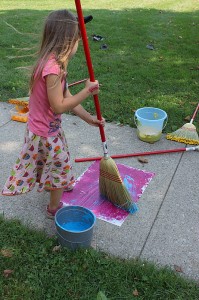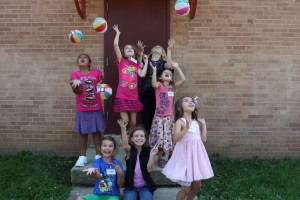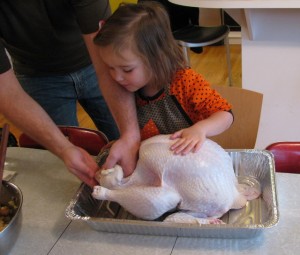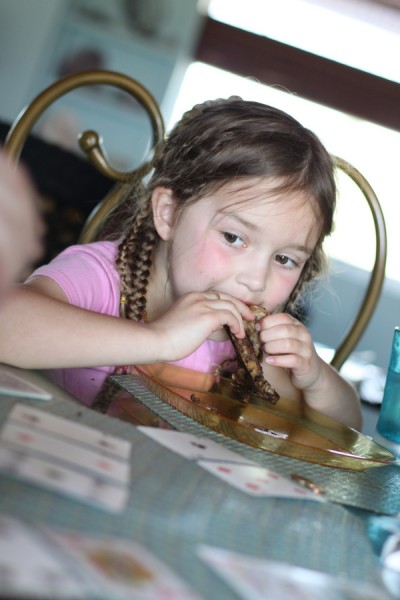 The other day, a friend asked for help with her picky eater. Children who only eat a few things are endlessly frustrating to their parents who are concerned about nutrition and also bored out of their mind eating the same thing every night.
I known this frustration personally. My sweet Lil, who loves planning edible gardens, has witnessed a chicken butchering, travels around the world, and has been welcome in the kitchen from day one, is a highly selective eater. Her favorite foods are healthy but I can't afford to feed her salmon nigiri, kiwi, and Parmesan cheese day in and out, not to mention that they aren't local or able to be made by me.
The other day, a friend asked for help with her picky eater. Children who only eat a few things are endlessly frustrating to their parents who are concerned about nutrition and also bored out of their mind eating the same thing every night.
I known this frustration personally. My sweet Lil, who loves planning edible gardens, has witnessed a chicken butchering, travels around the world, and has been welcome in the kitchen from day one, is a highly selective eater. Her favorite foods are healthy but I can't afford to feed her salmon nigiri, kiwi, and Parmesan cheese day in and out, not to mention that they aren't local or able to be made by me.
Dining development
I read a good bit of child development literature because I am totally fascinated by human development. I watch kids carefully at cooking classes and have noticed some patterns that are supported by developmental activities.
I have a theory that at age 2, most kids are high on the power of self feeding that they eat a huge variety of foods. Lil used to eat whole sweet peppers, every kind of fruit, sauces, and more.
By age 4, kids are experimenting with exerting power against other people and often refuse foods because they can. So much is going on socially and emotionally that many 4-5 year olds stick with very basic foods so they don't have to spend much energy processing new flavors and textures. Many children exhibit sensory issues around this age that make crunchy, soft, or chewy food very unpleasant for them. These developments are all normal.
Selective eaters tend to get into a pattern of enjoying just a few types of food throughout elementary school. Their willingness to try new foods often returns in the ever-experimental teens.
So what can a concerned parent to do?
With children wanting to eat every day (three times, even!), it is easy to get caught up in daily worry about foodstuffs. If you cave to unhealthy foods and/or spend mealtimes nagging, kids are picking up the message that it's ok to ignore healthy choices and eating meals with those you love is not a priority.
So parents must take the long view. Focus on the lifelong habits that mindful eating can make. The ultimate goal of family dining must be to make and serve a variety of healthy foods and instil the value of slowing down to eat with those you love.

Mealtime Survival Tips
I don't believe in tricking kids into eating foods they don't want by adding purees to their favorite foods. I think kids should learn to love foods in their natural state, not covered up with stronger flavors. Similarly I don't believe in rewarding healthy eating with sweet treats. Both send the wrong message: that one must force themselves to eat nutritious food.
That said, I have found some tricks that help our meals with choosy Lil go more smoothly.
1)Try a family healthy eating challenge - Lil was very motivated last year when we made a chart and recorded how many fruits and vegetable each person ate each day. It helps that Alex is not a great produce eater so he was falling behind the goal of five servings too. Another challenge could be to buy a fruit/veg once a week that none of you have eaten before and prepare it.
2)If your child is into pretend play, ask him/her to eat like a bunny/monkey/elephant/any animal with a produce-rich diet. For some reason Lil was excited about raw kale for awhile because it was 'bunny food'. I let her nibble at mint out of the garden when she's crawling around like a kitty because it's green and has to be good for her, despite the germs.
3)Try a different preparation - Lil is recently on a frozen produce kick. I know it's not as healthy as fresh but a bowl of frozen peas is a heck of a lot better for her than a bowl of crackers. She likes frozen peach slices and berries too.
4) Give the child lots of power - If they can handle choices, give very simple a or b selections, i.e. "would you like apples or bananas for lunch?" Encourage them to help arrange a fruit plate or create a salad or push the button on the smoothie blender. Even if they don't eat the finished product, I can almost always get a child to take a bite of something they helped create.
5) Serve something they like at every meal - We always serve something Lil likes that she can choose to fill up on if she doesn't like other dishes. Often this means we pull out a piece of chicken before we add sauce or a portion of rice before mixing it with vegetables.
6) Serve everything at every meal - Put a tiny portion of each item you serve on the child's plate even if they've rejected the foods a thousand times. This communicates that a variety of foods is healthy and there's always a chance to change your mind.
7) Ask for input during meal planning - We meal plan as a family on Sunday morning, sitting around the dinner table and talking through the week, fresh produce, and what we want to eat. This is a good time to demonstrate compromise: everyone gets some of what they want on the menu but no one loves every meal.
8 ) Make changes slowly - If you typically make exactly what your child wants for every meal, changing that pattern will cause some stress. Offer one new food or preparation a day so as to not overwhelm them.
9) Never say 'picky' - Labeling a problem gives credence to it. If someone asks "Is X a picky eater?" I say "X likes y, y, and y." If I'm feeling saucy, I add "We eat dinner together every night. Do you?"
10) Breathe and relax - Your job as the parent is to provide the food. The child's job is to choose what to eat.
Do you have a picky eater? How do you deal?
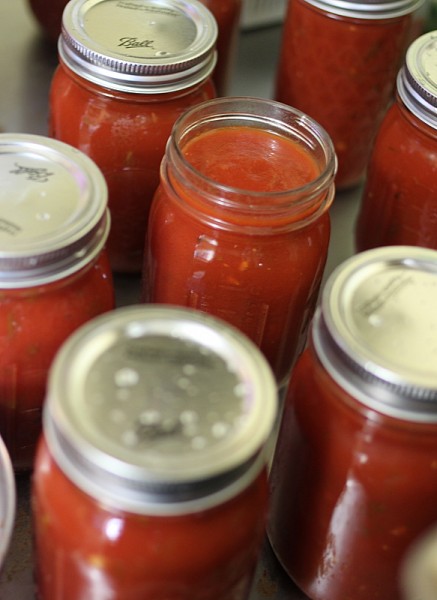 Do you ever feel like the only jar without a lid? I do.
When my kid climbs up the slide, I see the looks from other parents who wouldn't dare let their kid break the 'rules'. I confuse adults when I redirect them to ask my child questions and then listen to her answers because most adults act like kids can't think or speak for themselves. And the opinions about our choice to raise an unschooled, only child? I attract comments like fleece attracts dog hair, even from strangers!
Do you ever feel like the only jar without a lid? I do.
When my kid climbs up the slide, I see the looks from other parents who wouldn't dare let their kid break the 'rules'. I confuse adults when I redirect them to ask my child questions and then listen to her answers because most adults act like kids can't think or speak for themselves. And the opinions about our choice to raise an unschooled, only child? I attract comments like fleece attracts dog hair, even from strangers!


